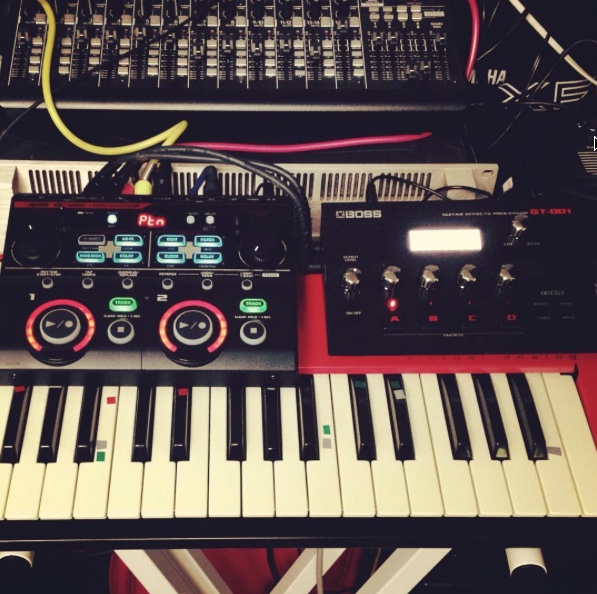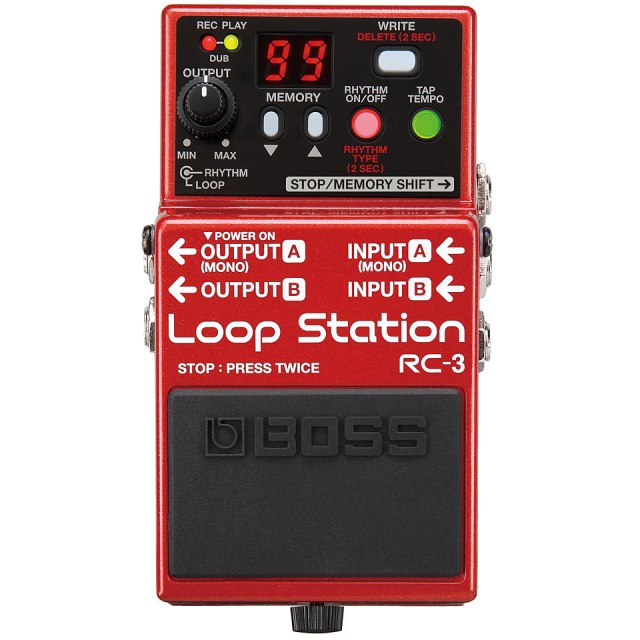
Just today I found a used Boss GT-001 effect processor and thought the size and form factor was perfect for the Nord Lead 2. I was interested in the Tera Echo effect that can be found in the GT-001 as well. I was going to buy a dedicated Tera Echo but for a little more that a used one I could get the GT-001 and have a whole slew of effects for the Nord Synth and other stuff. So far, the GT-001 which is similar to the Boss GT-100 has been a wonderful addition. Below are some initial thoughts as I worked with it today.
First, there is no dedicated BYPASS switch on the Boss GT-001. To start fresh or basically have a patch initialized, I turned all the effect data off and saved a dummy patch called “BYPASS”. I then assigned it to Favorite A button which allows me to call up the Bypass patch at anytime. The GT-001 probably colors the synth sound a little but I didn’t really notice any major sound difference. There is also a bypass switch located in the Tuner function, but found just creating a dedicated patch to work fine. I’m not even sure if the Tuner bypass function will work as desired anyway.
The second favorite B patch I created was a simple EQ and Reverb Combo Patch for the Nord Lead 2. This allows me to boost the bass, add mids, or sprinkle some reverb onto the basic sound. I then created a Favorite C patch that added some Tera Echo and that was a blast to work with. I love that Tera Echo on the Nord. Finally, my initial Favorite D patch is a dotted 8th note delay which is fun to play along with the Boss RC-202. You can dial in the BPM, so although there is no external midi sync, one can effectively play with the same BPM which works just fine in my book.
Like I mentioned above there are no Midi Din jacks on the back. Yes, that’s a shame, but the GT-001 does allow you to dial in the BPM to match your synth, sequencer, or in my case the Boss RC-202. I actually have the Nord Lead 2 midi’d up to the Boss RC-202 so that the RC-202 controls the Nord’s arp tempo. The Boss GT-001 I just punch in the BPM and I’m set. So far I’ve had zero timing issues. For live playing, I think this setup works just fine, but for studio recording, one might wish for the dedicated midi connections.
The individual effects and effect chain are very easy to control with the GT-001 itself. You actually do NOT need the Tone Studio software to work with the GT-001. I did however spend some time with the GT Tone Studio doing some basic tweaks on all of the patches to make them more “synthesizer” friendly. I now have a 200 patch bank of synth patches without all of the guitar and vocal oriented effects added. Reverbs, EQ, OD, Delay, Chorus, Comp, and a few other effects were changed to sound better with a synthesizer. A cool thing about the GT-001 is you can create your own user category for the 200 patches. So, I was able to create a “SYNTH Category” and keep my synth patches separate from the guitar ones. Very nice.
My hardware setup is basically the Nord Lead 2 connected to the Boss GT-001 which then goes into the Boss RC-202. The RC-202 then goes into my mixer and out my PA system. While the effects are excellent in the Boss RC-202, I enjoy creating specific synth patches on the Boss GT-001 that might consist of several effects at once. Basically,like a stomp box, the Boss RC-202 is easy to quickly turn on and off effects. While the Boss GT-001 does have four favorite buttons, it is not as easy to disengage individual effects on the fly. However, it is VERY easy to sculpt your own sound and then save that patch for a one click solution.
I have not tried using the foot controller option for the Boss GT-001 just yet. I plan to plug in an expression pedal most likely. I also haven’t used the XLR jack yet which provides a mic option. I actually use both a Boss VE-20 and TC-Helicon Voice Live 2 for vocals, so it’s likely I won’t use that feature anytime soon. It’s nice to have it though. The build is not that bad with the Boss GT-001 and I like very “light” objects on my synthesizers to avoid devices falling or banging the expensive synth gear. So while guitar players might cringe at the light plastic feel of the GT-001, us synth players might actually prefer it. The Boss RC-202 has a better build by the way than the GT-001, but not by much. Note that the Boss GT-001 and Boss RC-202 are not battery powered in case someone asks.
While the Boss GT-001 is not setup for synths straight out of the box, it can handle them very well once you go in and tweak the patches. The preset patches are awful for the Nord Lead which is why I spent and hour or so tweaking all of the 200 patches in the Tone Studio Software on the Mac to my liking. I then could tolerate and tweak further with the synth plugged in. The effects are shaping up really nice now and it’s so nice to have such a small, yet powerful effects unit on the Nord Lead. The effects do sound great and definitely help the Nord Lead 1, 2, and 3 catch up to the Nord A1 in terms of that vintage effect sound. The GT-001 fattens up the Nord very nicely.
I’ll update this post further with additional thoughts as I progress with the Boss GT-001 effect processor.





